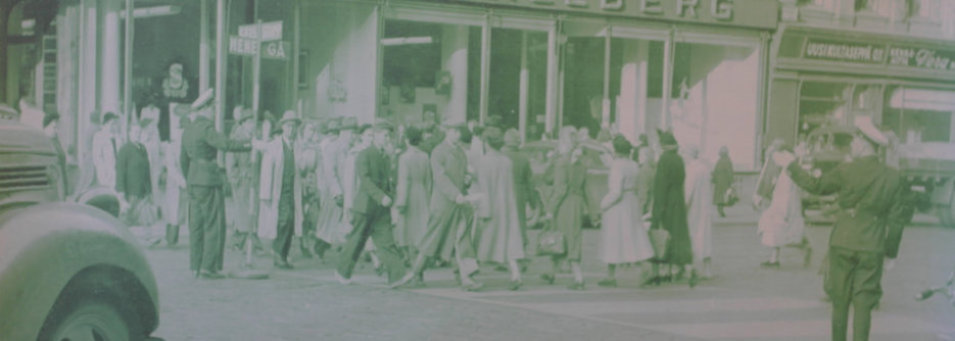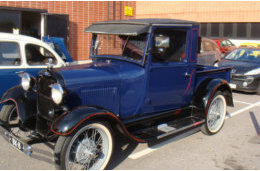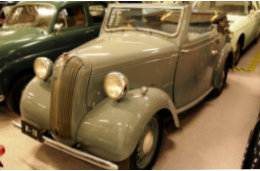










Collection of the roaring 20´s, 30´s and 40´s


Ford A Pick Up - 1929
Brought from U.S.A. in mint condition, only slightly renoved in Finland. Car is in traffic
slightly renoved in Finland. Car is in traffic condition, registered as a museum car and it
condition, registered as a museum car and it has been driven occasionally to keep
has been driven occasionally to keep everything working. Car has also had a short
everything working. Car has also had a short movie carrier in the film Hella Vuolijoki.
movie carrier in the film Hella Vuolijoki.


Ford Prefect - 1939
The Ford Prefect is a line of British cars produced by the UK division of the Ford
produced by the UK division of the Ford Motor Company, and a more upmarket
Motor Company, and a more upmarket version of its direct siblings the Ford Popular
version of its direct siblings the Ford Popular and Ford Anglia.
and Ford Anglia. 


Standard Flying Eight - 1948
The Standard Eight is a small car produced by the British Standard Motor Company from
the British Standard Motor Company from 1938 to 1959.
1938 to 1959. The car was originally launched in 1938 as
The car was originally launched in 1938 as the Flying Eight. After the Second World War
the Flying Eight. After the Second World War the Flying range of Standards was dropped
the Flying range of Standards was dropped but an updated car called the 8 hp was re-
but an updated car called the 8 hp was re- introduced in 1945. In 1953 a completely new
introduced in 1945. In 1953 a completely new car, the Standard Eight was launched sharing
car, the Standard Eight was launched sharing virtually nothing with its predecessor. In 1959
virtually nothing with its predecessor. In 1959 the car was dropped to be replaced by the
the car was dropped to be replaced by the Triumph Herald, as the Standard brand was
Triumph Herald, as the Standard brand was being phased out.
being phased out.





1920-1929
The Roaring Twenties is a term sometimes used to refer to the 1920s in the United States, Canada, and the United Kingdom, characterizing the decade's distinctive cultural edge in New York City, Chicago, Paris, Berlin, London, Los Angeles and many other major cities during a period of sustained economic
distinctive cultural edge in New York City, Chicago, Paris, Berlin, London, Los Angeles and many other major cities during a period of sustained economic prosperity. French speakers called it the "années folles" ("Crazy Years"), emphasizing the era's social, artistic, and cultural dynamism. Normalcy returned
prosperity. French speakers called it the "années folles" ("Crazy Years"), emphasizing the era's social, artistic, and cultural dynamism. Normalcy returned to politics in the wake of hyper-emotional patriotism after World War I, jazz music blossomed, the flapper redefined modern womanhood, and Art Deco
to politics in the wake of hyper-emotional patriotism after World War I, jazz music blossomed, the flapper redefined modern womanhood, and Art Deco peaked. Economically, the era saw the large-scale diffusion and use of automobiles, telephones, motion pictures, and electricity, unprecedented
peaked. Economically, the era saw the large-scale diffusion and use of automobiles, telephones, motion pictures, and electricity, unprecedented industrial growth, accelerated consumer demand and aspirations, and significant changes in lifestyle and culture. The media focused on celebrities,
industrial growth, accelerated consumer demand and aspirations, and significant changes in lifestyle and culture. The media focused on celebrities, especially sports heroes and movie stars, as cities rooted for their home team and filled the new palatial cinemas and gigantic stadiums. In most major
especially sports heroes and movie stars, as cities rooted for their home team and filled the new palatial cinemas and gigantic stadiums. In most major countries women won the right to vote for the first time. Finally the Wall Street Crash of 1929 ended the era, as the Great Depression set in, bringing
countries women won the right to vote for the first time. Finally the Wall Street Crash of 1929 ended the era, as the Great Depression set in, bringing years of worldwide gloom and hardship.
years of worldwide gloom and hardship. The social and cultural features known as the Roaring Twenties began in leading metropolitan centers, especially Chicago, New Orleans, Los Angeles,
The social and cultural features known as the Roaring Twenties began in leading metropolitan centers, especially Chicago, New Orleans, Los Angeles, New York City, Philadelphia, Paris and London, then spread widely in the aftermath of World War I. The United States gained dominance in world
New York City, Philadelphia, Paris and London, then spread widely in the aftermath of World War I. The United States gained dominance in world finance. Thus when Germany could no longer afford war reparations to Britain, France and other Allies, the Americans came up with the Dawes Plan and
finance. Thus when Germany could no longer afford war reparations to Britain, France and other Allies, the Americans came up with the Dawes Plan and Wall Street invested heavily in Germany, which repaid its reparations to nations that in turn used the dollars to pay off their war debts to Washington.
Wall Street invested heavily in Germany, which repaid its reparations to nations that in turn used the dollars to pay off their war debts to Washington. By the middle of the decade, prosperity was widespread, with the second half of the decade later becoming known as the "Golden Twenties".
The spirit of the Roaring Twenties was marked by a general feeling of discontinuity associated with modernity and a break with traditions. Everything
By the middle of the decade, prosperity was widespread, with the second half of the decade later becoming known as the "Golden Twenties".
The spirit of the Roaring Twenties was marked by a general feeling of discontinuity associated with modernity and a break with traditions. Everything seemed to be feasible through modern technology. New technologies, especially automobiles, moving pictures and radio proliferated "modernity" to a
seemed to be feasible through modern technology. New technologies, especially automobiles, moving pictures and radio proliferated "modernity" to a large part of the population. Formal decorative frills were shed in favor of practicality in both daily life and architecture. At the same time, jazz and
large part of the population. Formal decorative frills were shed in favor of practicality in both daily life and architecture. At the same time, jazz and dancing rose in popularity, in opposition to the mood of the specter of World War I. As such, the period is also often referred to as the Jazz Age.
1930-1939
After the Wall Street Crash of 1929, the largest stock market crash in American history, most of the decade was consumed by an economic downfall
dancing rose in popularity, in opposition to the mood of the specter of World War I. As such, the period is also often referred to as the Jazz Age.
1930-1939
After the Wall Street Crash of 1929, the largest stock market crash in American history, most of the decade was consumed by an economic downfall called the Great Depression that had a traumatic effect worldwide. In response, authoritarian regimes emerged in several countries in Europe and South
called the Great Depression that had a traumatic effect worldwide. In response, authoritarian regimes emerged in several countries in Europe and South America, in particular the Third Reich in Germany. Weaker states such as Ethiopia, China, and Poland were invaded by expansionist world powers, the
America, in particular the Third Reich in Germany. Weaker states such as Ethiopia, China, and Poland were invaded by expansionist world powers, the last of these attacks leading to the outbreak of the Second World War a few months before the end of the decade. The 1930s also saw a proliferation of
last of these attacks leading to the outbreak of the Second World War a few months before the end of the decade. The 1930s also saw a proliferation of new technologies, especially in the fields of intercontinental aviation, radio, and film.
new technologies, especially in the fields of intercontinental aviation, radio, and film. 1940-1949
Most of the Second World War took place in the first half of the decade, which had a profound effect on most countries and people in Europe, Asia, and
elsewhere. The consequences of the war lingered well into the second half of the decade, with a war-weary Europe divided between the jostling
1940-1949
Most of the Second World War took place in the first half of the decade, which had a profound effect on most countries and people in Europe, Asia, and
elsewhere. The consequences of the war lingered well into the second half of the decade, with a war-weary Europe divided between the jostling spheres of influence of the West and the Soviet Union, leading to the beginning of the Cold War. To some degree internal and external tensions in the
spheres of influence of the West and the Soviet Union, leading to the beginning of the Cold War. To some degree internal and external tensions in the post-war era were managed by new institutions, including the United Nations, the welfare state and the Bretton Woods system, facilitating the
post-war era were managed by new institutions, including the United Nations, the welfare state and the Bretton Woods system, facilitating the post–World War II boom, which lasted well into the 1970s. However the conditions of the post-war world encouraged decolonialization and emergence of
post–World War II boom, which lasted well into the 1970s. However the conditions of the post-war world encouraged decolonialization and emergence of new states and governments, with India, Pakistan, Israel, Vietnam and others declaring independence, although rarely without bloodshed. The decade
new states and governments, with India, Pakistan, Israel, Vietnam and others declaring independence, although rarely without bloodshed. The decade also witnessed the early beginnings of new technologies (including computers, nuclear power and jet propulsion), often first developed in tandem with
also witnessed the early beginnings of new technologies (including computers, nuclear power and jet propulsion), often first developed in tandem with the war effort, and later adapted and improved upon in the post-war era.
the war effort, and later adapted and improved upon in the post-war era.



Photos mainly by Matti Kreivilä. Historical facts and technical details of the vehicles provided by Wikipedia. Movies YouTube.









